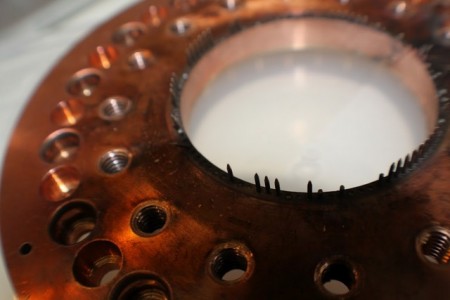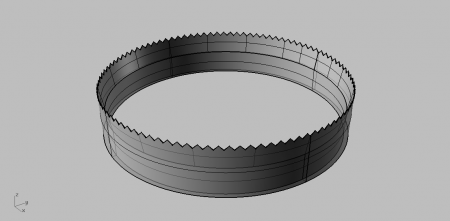Mar
27
Lerner’s Focus Fusion Meets the Boron Fuel Line
March 27, 2012 | 3 Comments
Dr. Eric Lerner’s Focus Fusion machine at Lawrenceville Plasma Physics (LPP) in New Jersey is heating and confining an ionized gas at record temperatures equivalent to over 1.8 billion degrees C, as described in a paper published March 23rd in Physics of Plasmas, the most often cited journal devoted to plasma physics published by the American Institute of Physics.
One point eight billion degrees is a temperature high enough to ignite the nuclear fusion of “aneutronic” fuels like hydrogen and boron. Such aneutronic fuels, which produce no neutrons, could generate energy that can be converted directly into electricity, without going through the capital intensive cycle of generating steam, driving it through turbines and re-cooling the steam and water.
The peer reviewed paper shows that the firm has achieved two of three criteria for net fusion energy. This news can put some meaning to garage-sized fusion generators that might be possible in a few years.
These results came before the Focus Fusion device hit a design limit. Late in January a ceramic insulator broke in late January, damaging the nearby cathode base. This base takes the plasma charge and sends it away. The temperature achievement price is a new and better cathode.
The new design presented some new challenges. The team made a small change from 100 to 96 tungsten pins (since 96 is a nice even multiple of the 16 cathode rods). The tiny (40-mil, or .040″) holes that held the tungsten pins on the inside edge of the plate proved extremely challenging for the firm’s regular machinist, due to their size and the softness of copper.
The tungsten pins are critical to the functioning of Focus Fusion machine because the current starts to flow from them and forms into filaments and the overall plasma sheath.
Research team members Aaron Blake and Derek Shannon designed a more robust substitute for the pins choosing to design a serrated ring of tungsten, with the saw tooth points substituting for the points of the pins. LPP has located a much larger machine shop which uses electrical discharge machining (EDM), a highly precise method of machining with intense electric currents making a very appropriate method for the high voltage happy Focus Fusion machine.
The new ring of tungsten teeth is expected to arrive in early April. That will allow LPP to resume firing, confident they will have a highly symmetric set of electrodes. This symmetry is essential to achieving good compression of the plasma and producing higher fusion yields.
Dr. Lerner, Chief Scientist at LPP explains the significance of the two out of three criteria results that have passed the peer review process, “The research reported in the paper shows that we have achieved two of the three conditions needed to scientifically demonstrate net energy production with aneutronic fuels. We have demonstrated the extremely high ion energies needed to ignite this fuel, and the confinement time of tens of nanoseconds that we need to burn it. We are still far from having sufficient density in the tiny hot regions to get net energy, but that is our next goal.”
This is progress. About a year ago LPP had reported energies for ions of 1.1 billion degrees, equal to record temperatures for the dense plasma focus device that had stood since 1978. The new work shatters those long-standing records and, most importantly, crosses the threshold temperature expected that’s needed to burn aneutronic fuels.
The paper, is titled Fusion Reactions From >150 keV Ions in a Dense Plasma Focus (DPF) plasmoid also lays to rest a long-standing scientific controversy with major implications for whether the DPF is a viable source of useful fusion energy.
Lerner’s team shows conclusively that the majority of fusion reactions in LPP’s DPF come from confined, circulating ions, and not from a beam of ions just passing through once. If fusion reactions in a DPF come primarily from an unconfined beam, then the fusion yields are unlikely to scale to useful quantities of energy.
On the other hand, if, as this research has shown, the fusion reactions take place primarily between ions confined within a concentrated ball of plasma (a “plasmoid”), then the energy from the reactions will be trapped and will heat the plasmoid up further, leading to a complete burn and net energy production.
The paper is available from LPP by personal request.
The LPP research team is currently upgrading their fusion device to achieve the higher densities required for net energy, a goal they hope to achieve soon.
Dr. Lerner and his team have come a long way since the idea was glimmering thought in mind. The next threshold is net energy production, a significant event that should garner worldwide attention and considerable acclaim. These folks deserve it, although I doubt they have the hubris to make much of it – the humble sincerity your writer has experienced with these folks is a refreshing experience grounded in reality.
The new parts are also a confidence builder. The LPP team is a pretty sharp group and one can fairly expect the engineering at the start to have been right at what the plan envisioned – but the plan is being exceeded. In an odd way one hopes there will be more and better equipment need to scale up the output, because that tells us the potential is higher than first expected.
Go guys, step by step until something else fails, maybe you’ll get some net energy first. Either way, the concept looks better with every shot.
Comments
3 Comments so far




The simple key is going to be controlling the plasma spin and density with small magnetic fields. Tuning plasma, like tuning a carburetor, is going to be imperative for optimizing the fusion process.
And if you can’t tune your plasma, then realign your dilithium crystals!
I wish to encourage you Dr. Eric Lerner and LPP Team. GO for it! This kind of revolution is so needed for Power production, Spaceflight, etc. Just keep on and get the job done well ! Fascinating work that could change history with much positive gain for the people of this world.
Blessings On You All !
Curt Dallaire
I have to thank you for the efforts you have put in penning this
site. I am hoping to see the same high-grade content by you later
on as well. In truth, your creative writing abilities has encouraged me to get my own site now 😉